Tired of paying so much for expensive store-bought dairy kefir or probiotic supplements?
Where to Get Kefir Grains for Inexpensive Probiotics Plus How and Why to Make Milk Kefir
If you just want to know how to make it, scroll down or jump here for instructions, but first here's a video showing you how easy it is to make this AND sourdough, and then keep reading for the back story… (Video plays after the ad.)
As my longtime readers know, I've been making water kefir, also called kefir soda, for a while now. Although I have taken a break from that since the explosions–yep, that's plural. Apparently there was some over-fermentation going on in that batch, ughhh. (Here's how to make kefir soda pop, pictured here is the time we added raspberries to the second ferment, it was delicious!)
As easy as it is to make kefir water, though, making dairy kefir is even more simple and it's my new favorite!
I hadn't got into it before because I'm not a fan of drinking fizzy dairy, that just didn't sound appealing! And for getting extra probiotics in my recipes, I'd usually add some organic whole milk yogurt from the store. It's not easy to find, but not impossible, and unless you're using the powdered yogurt starters, then yogurt isn't the easiest thing to keep on hand. (I've heard that the powdered starters aren't the greatest anyway, you can only use it for a couple of batches and it also doesn't have as much beneficial bacteria.)
Then I learned about how much more beneficial bacteria (probiotics) are in kefir compared to yogurt, and I knew it was time to start getting milk kefir into my family!
Milk kefir is quite different from yogurt in that the strains contained colonize the intestinal tract and don’t just pass through with temporary benefit. Some of the strains in kefir are aggressive in nature too, which means they attack and destroy pathogens reasserting dominance and control of the intestinal environment.
This is why eating a ton of kefir when you have gut imbalance issues can sometimes trigger a temporary healing crisis from pathogen die-off in the gut. Eating lot of yogurt rarely causes this type of reaction as the effect on digestive health is much milder.
In addition, kefir contains a lot larger range of bacteria, as well as beneficial yeasts which combat Candida problems. (Source)
The only problem…
When I first got my milk kefir grains here, I read in the instructions that you really can't activate them in raw milk because it won't work. (“Raw milk contains its own bacteria, those bacteria can introduce competition for the rehydrating grains and keep them from activating properly.”) So I knew I was going to have to bite the bullet and buy some regular factory-farm milk from the store. I know that's all some of you still drink, and yes it's about taking baby steps when you're able, I get it, but it had been a loooong time since I had to go to that part of the store…
Remembering, though, how Sally said that cream is less denatured in pasteurization than milk, I figured I'd just get some of that. When I was in the store about to buy it, however, I thought, “First maybe I should find out if that's okay…” So I looked on my phone and found an old number for Julie at Cultures for Health. When the business first began she was a one-man-show working from her home, but nowadays she's got many employees and a whole office, so I was fully assuming customer service would pick up.
Guess who picked up instead?
Julie! What I thought was a customer service number went right to her line. It was great catching up and we ended up talking for another half hour while I grabbed the rest of my groceries. Yep, that was me at the store, being annoying, talking on my phone.
But it's a good thing I called!
Turns out there's no way around it, you really have to activate your kefir grains with regular pasteurized milk, cream won't work, and my store didn't have any organic milk that was not ultrapasteurized, so I had to get the factory-farmed milk. (Don't get low-fat obviously, which is true no matter what!) Julie reassured me, though, that very soon, I'd be able to transition it over 100% to my raw milk. 🙂
Here's Julie showing how to activate your kefir grains:
How to make milk kefir
- First either get your kefir grains here and activate them as shown above, OR just get some kefir grains from a friend which I did another time when my friend Amy shared with me! If you're wondering what they're like, they're just squishy cauliflower-looking things:
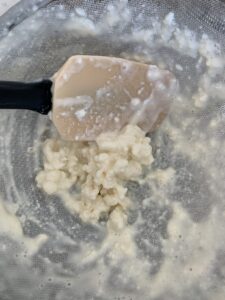
- Add your grains to a pint of fresh milk (using either regular pasteurized milk or fresh raw milk are both fine, but there are extra instructions for transitioning over to raw milk at first, as mentioned above; and never use ultrapasteurized dairy, which again, you don't want in your kitchen anyway! You'll know it's ultra-pasteurized if it says UHT on it and/or the use-by date is 2 or more months out.) and set it on the counter for a day or two (I do one day so it's not too sour), covered with a coffee filter and a rubber band as pictured here. THAT'S IT. No messing around with warming or getting the temperature just right like you have to with yogurt. It's all so easy!
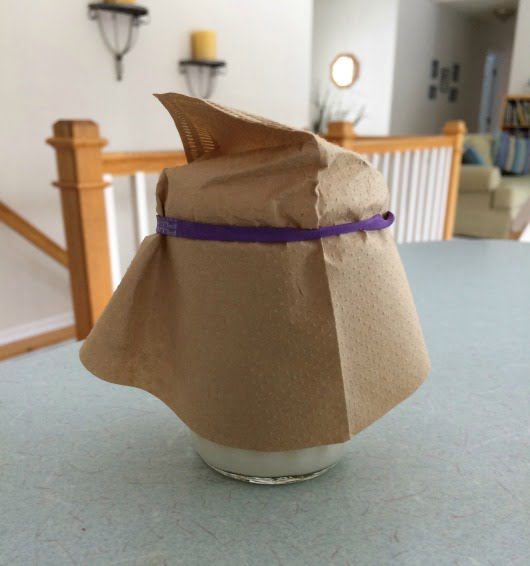
- The warmer your room is, the faster it'll ferment. You'll know it's ready when it's sort of globby (don't know how else to describe it!), which means it has thickened up some. As she shows in the video below, if you wait longer (further past just the “globby” stage) it'll separate into curds and whey, which is still fine to use or to drink, but it'll have a stronger flavor. Some people like my friend Kay love it like that and others like it milder–just keep that in mind when you decide how long to let it ferment on your counter. Here's Kay's milk kefir which she lets go a bit longer than I do:
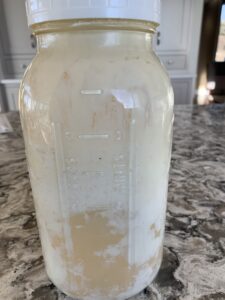
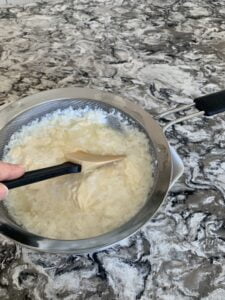
- Either way, you end up with what looks like a pourable yogurt:
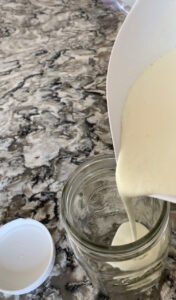
- To stop the fermentation, just put it in your fridge.
- Put a mesh strainer over a bowl, and use a rubber spatula or wooden spoon to stir around the kefir to get it all strained, leaving the kefir grains in the strainer. Here's the strainer I use:
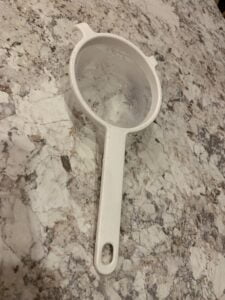
- Transfer the dairy kefir to a jar, label it, add a lid, then put it in the fridge to use as needed–see below for lots of ideas for how to use it! My favorite is to throw it into superfood smoothies, but there are many many other ways too!
- Transfer the kefir grains to a jar with enough milk to cover, add a lid, and label this too. Keep in the fridge 'til you make more.
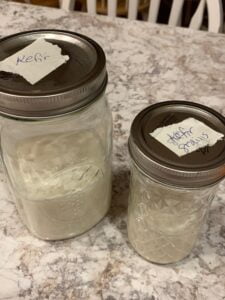
Here's Julie showing how to make milk kefir:
Inexpensive probiotics!
As mentioned above, dairy kefir is loaded with good bacteria/probiotics, so you're getting those immune-system, disease fighting benefits, without buying expensive store-bought kefir or probiotic supplements! Granted, sometimes you need those big guns, but for everyday, consuming dairy kefir is a great way to maintain good health! (If you need them, the “big gun” probiotics I recommend are here.)
How long in the fridge & how to keep your kefir grains alive if you're not ot making it very often?
If my friend Kay is going on vacation, she'll put her kefir grains in a half-gallon jar and fill with 3/4 raw milk and says it's good for 4 weeks or longer!
But normally, you can just keep your grains in the fridge in a jar covered with milk for a week or so, and when you're ready to make/ferment more, just pull it out, put it in a jar with fresh milk, and leave it on the counter until it's globby as mentioned above. 🙂
I have a note in my phone to make more dairy kefir weekly (& usually another batch of smoothies), or if I'm not making more, I'll strain the kefir grains and cover them with fresh milk and put them back in the fridge.
A different option:
Another friend said that once when she was going to be gone for two weeks, here's what she did with her kefir grains:
- Rinse the grains well and place on a towel to dry out.
- Put them into a sealed jar and store in freezer.
- To “bring them back”: cover the kefir grains with milk and change the milk daily for 10 days or so, then proceed as before. She said normally she uses milk from the health food store–it's low-temp pasteurized, non-homogenized, and in glass bottles; when bringing the kefir grains back and she was tossing some milk every day, she used a less expensive milk from the grocery store.
How to get more dairy kefir into your diet:
Now that I've been making it for a while, I'm finding TONS of ways to use it more, I'll basically add some to anything that calls for cream, cream cheese, sour cream, or yogurt, as long as your dish isn't hot as you stir it in, so it doesn't kill the good guys. (The beneficial bacteria.)
Try it in recipes like…
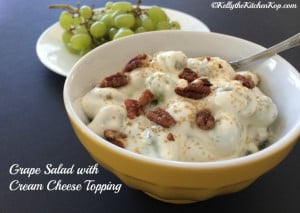
- Homemade ranch dip or ranch salad dressing, or any of the creamy salad dressings at this link.
- You could slip some into this homemade ice cream, but probably not too much or the slight twang of the milk kefir will be noticeable.
- My friend Blanca said she will sometimes just mix it with one banana, or a little sugar, and/or a teaspoon of vanilla.
- My friend Megan adds 1 teaspoon of Stevia plus the zest of one whole lime and said it's dreamy!
- Cucumber Garlic Radish Dip
- Easy Pita Dip
- Chicken salad
- Tasty Layered Taco Dip

- Cream cheese veggie dip
- Even cream-based main dishes or soups would be a good way to get the probiotics into your family, but just let it cool a bit before stirring some in.
- You get the idea — now what about YOU? Do you just drink milk kefir straight? My friend Kay does this every morning and she loves it.
Shopping:
- Just don't think you'll make it? Click here for the dairy kefir I buy when I don't have any made.
- Where to get water kefir grains or dairy kefir grains
- How to make water kefir/kefir soda pop
- Need stronger probiotics? Here's the kind we take.
- Visit here for more videos and recipes
- Read all about raw milk here and how we did our research before deciding to switch over

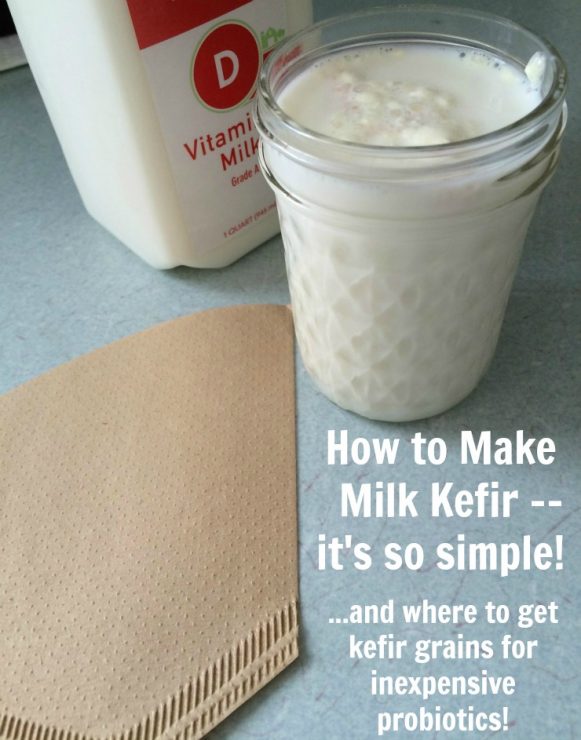
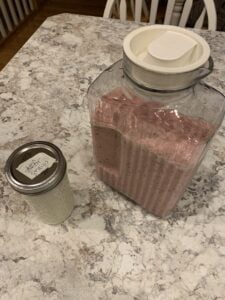
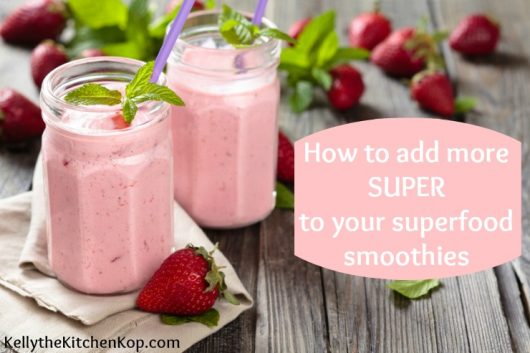


Margaret says
I’ve made raw milk kefir for years. It is super easy to make. I think the easiest way to get started with it is to find someone with extra grains to give away. My grains are so prolific, I almost always have some to give away.
Cathy Melchiori says
I make my own kefir daily with raw cows milk…so much better than store bought.
Geoffrey Noelle Stiles says
this is the best thing in my stay healthy arsenal… milk kefir made with my goat’s milk… (Noelle)
Dawn Block says
My homemade kefir is the one thing I truly miss being on the Whole30 plan…can’t wait to partake again soon!
Kelly the Kitchen Kop says
Yessssssss wine. Dawn Block!!!
KindFoodFarm says
It just grates on my ears to hear Julie pronounce it “KEE-fer” (like Kiefer Sutherland). The correct pronunciation is “kef-FEAR,” according to a friend of mine from the Republic of Georgia, where kefir is thought to originate. Otherwise, her explanations are always great!
KitchenKop says
Good morning Jeanmarie!
Funny you say that, because apparently I’ve always said it wrong too, lol!!! 🙂 I looked up more about how it’s pronounced, and some sites say exactly what you did, that it was originally from Russia, and pronounced “keh-fear”, and I also looked up what Julie from Cultures for Health says about it, just out of curiosity:
“The word kefir is said to stem from a Turkish word keif, which loosely translates to “good feeling,” most likely because of how consuming kefir made the people of the Caucasus feel. Kefir has been pronounced in different ways:
Ke-feer’ is one way that people pronounce it, sounding almost French with its short e followed by a long ee sound.
Kee’-fur is one of the more common ways it is pronounced in America. The long ee sound followed by the word fur is a more blunt pronunciation and perhaps the most popular.
Keh’-fur is another pronunciation that you will commonly hear and is often used by those of Middle Eastern descent.
There really is no right or wrong way to say kefir, as pronunciation varies in different cultures and communities.”
Interesting! 🙂
Kelly
Jeanmarie Todd says
I’m thinking I should start making this for my parents. It’s the best source of probiotics! It contains many more strains than other probiotic drinks, according to what I’ve read.
David Nay says
Raw milk Kefir seems to keep my wife’s asthma in check.
Kris Carver Peterson says
People with histamine issues may well NOT benefit from consumption of kefir or anything fermented. I think it is important to listen to your body but if you aren’t a careful listener and you have digestive issues, test for histamine intolerance.
ScooterandKelli Fortner says
I’m just trying to survive a 21 day cleanse involving keifer. I gag everyday.. It’s the nastiest stuff I’ve ever tasted! Is there any alternative?!
Kelly the Kitchen Kop says
Put it in a smoothie! https://kellythekitchenkop.com/add-more-super-to-your-superfood-smoothies/

Therese Garcia says
Thanks Kelly, I was just telling my chiropractor about how the kefir is helping with my spring allergies.
Tawnya Howell says
I seem to over ferment at times from being too lazy to strain, just wondering if the nutrient depletes or is it just as good?
KitchenKop says
@Sherry & Erin, I wondered that too, so I spoke to Julie directly (she owns C4H), as I explained above, and she said yes, you do need to use pasteurized milk. As to your 2nd question, whether or not you could just pasteurize (cook) your raw milk yourself, I didn’t ask her that, but that’s a great question, and I don’t know why that wouldn’t work! Maybe first search online for “how to pasteurize your own milk” or something like that.
Kelly
Sarah L. Peterson says
We drink it all the time in smoothies!
Sherry Hicklin says
I love my kefir, have been making it for years. I bought my grains online and they were not dehydrated so I started right away with my own raw milk. Do you have to use the pasteurized milk to start the dried cultures? Also couldn’t you pasteurize your own raw milk to start them? It really isn’t hard to do.
Erin Boyers Fox says
I wondered too?
Kelly the Kitchen Kop says
Sherry Hicklin & Erin Boyers Fox, I wondered that too, so I spoke to Julie directly (she owns C4H — read about our whole conversation at the post), and she said yes, you do need to use pasteurized milk. As to your 2nd question, whether or not you could just pasteurize (cook) your raw milk yourself, I didn’t ask her that, but that’s a great question, and I don’t know why that wouldn’t work! Maybe first search online for “how to pasteurize your own milk” or something like that.
Sherry Hicklin says
Been raising goats for over 20 years, pasteurizing milk is not hard. Easiest method: raise milk to 165 degrees hold for 15 seconds stirring to make sure all milk is up to temperature, this method leaves a very cooked tasting product. You can also heat milk to 140 and hold for 30 minutes then cool quickly, I hear it does not taste as strange then.
Sherry Hicklin says
Kelly the Kitchen Kop I did read the post I was just curious if the need to use pasteurized milk was because the cultures were dehydrated and perhaps were I don’t know weaker maybe is the word till they got going and then you could go to using raw milk once they were reconstituted and growing vigorously. 😀
Schlechten Wolf says
I had to acclimate my kids(myself) to fermented foods by adding cane sugar or maple syrup and gradually withdrawing it. Join fermenters kitchen on facebook for some seriously awesome inspiration. I recently chopped cranberries, orange, orange peel and added raw honey and a tad bit of kombucha liquid and fermented it on my countertop for three days. Ooooh baby! Its amazing!
Ilka Jones says
It is a bit of an acquired taste, though. Not sure if I could get my little guy (5yo) to drink kefir…
Jill-David Boman says
We never drink it straight–too sour. But it’s great in a smoothie!
Sherry Hicklin says
I use liquid stevia and glycerin based vanilla in mine. Love it!
Charity Wojciechowski says
I add a bit of maple syrup for my little ones.
Carrie says
Hello Kelly, did Julie hook you up with a discount code? I would love to order, thanks so much
KitchenKop says
No because they’re running sales quite often, keep an eye out!
KitchenKop says
WAIT!
Carrie, I just ran it by Julie again and here’s what she said she’d do:
15% off starter cultures
Coupon code: KELLY (She’s getting it into the system now, so don’t try until 3:00 pm Eastern)
Valid until 5/31/15
Kelly
Passade says
Hi Kelly, I had never heard of Kefir before. Thanks for introducing it to me. Indeed, dairy kefir has got some content to maintain a good health. Thanks again for posting this article, Kelly 🙂